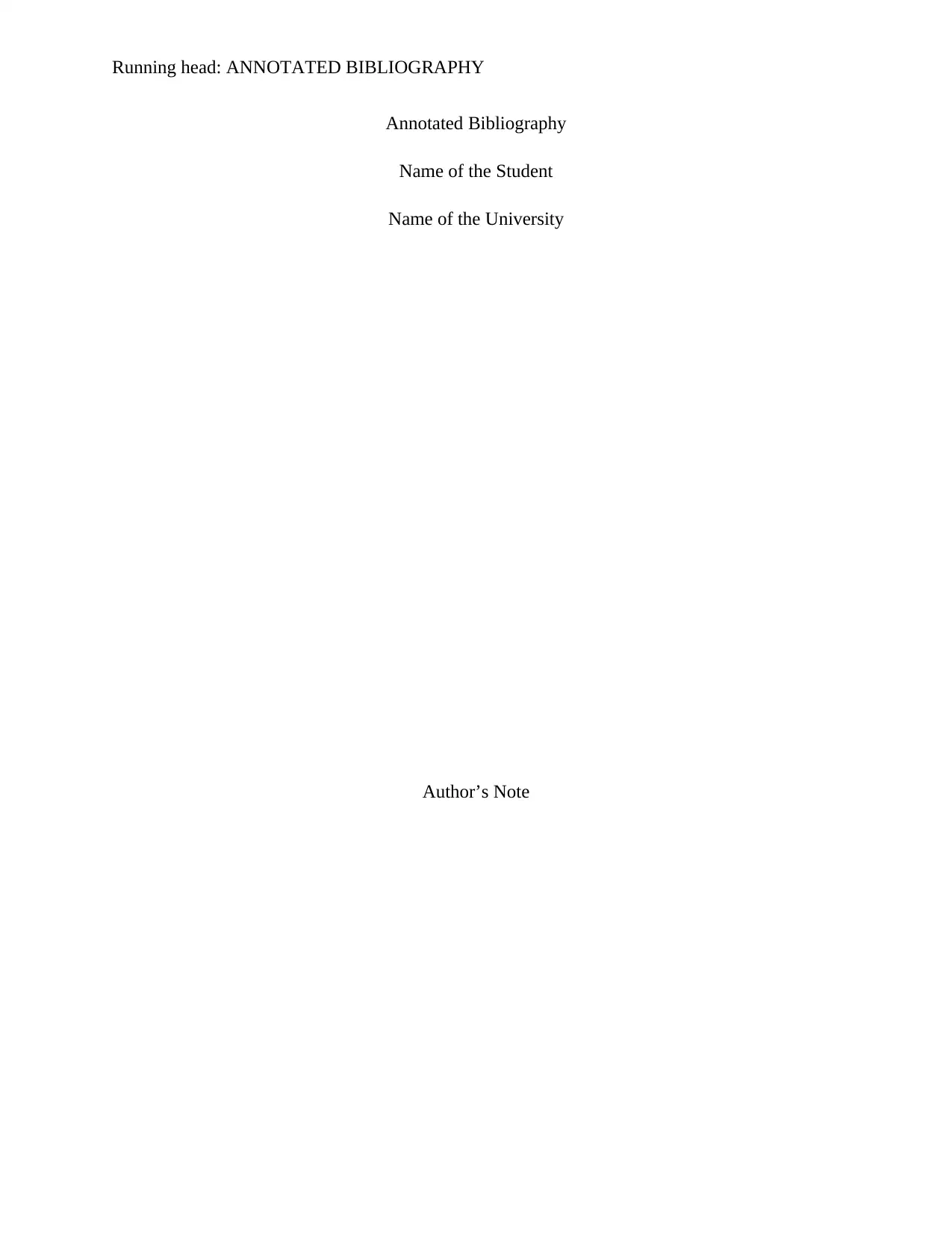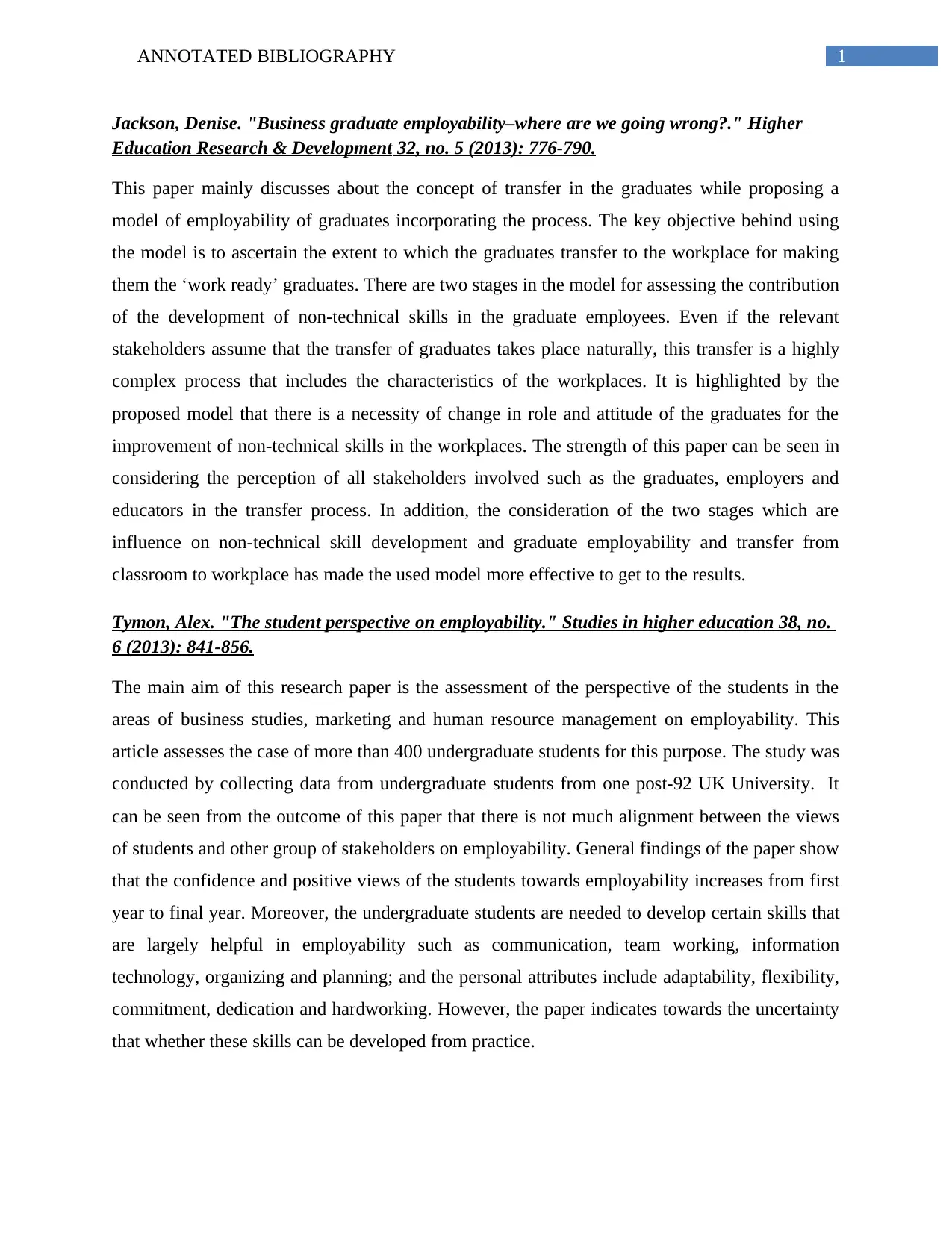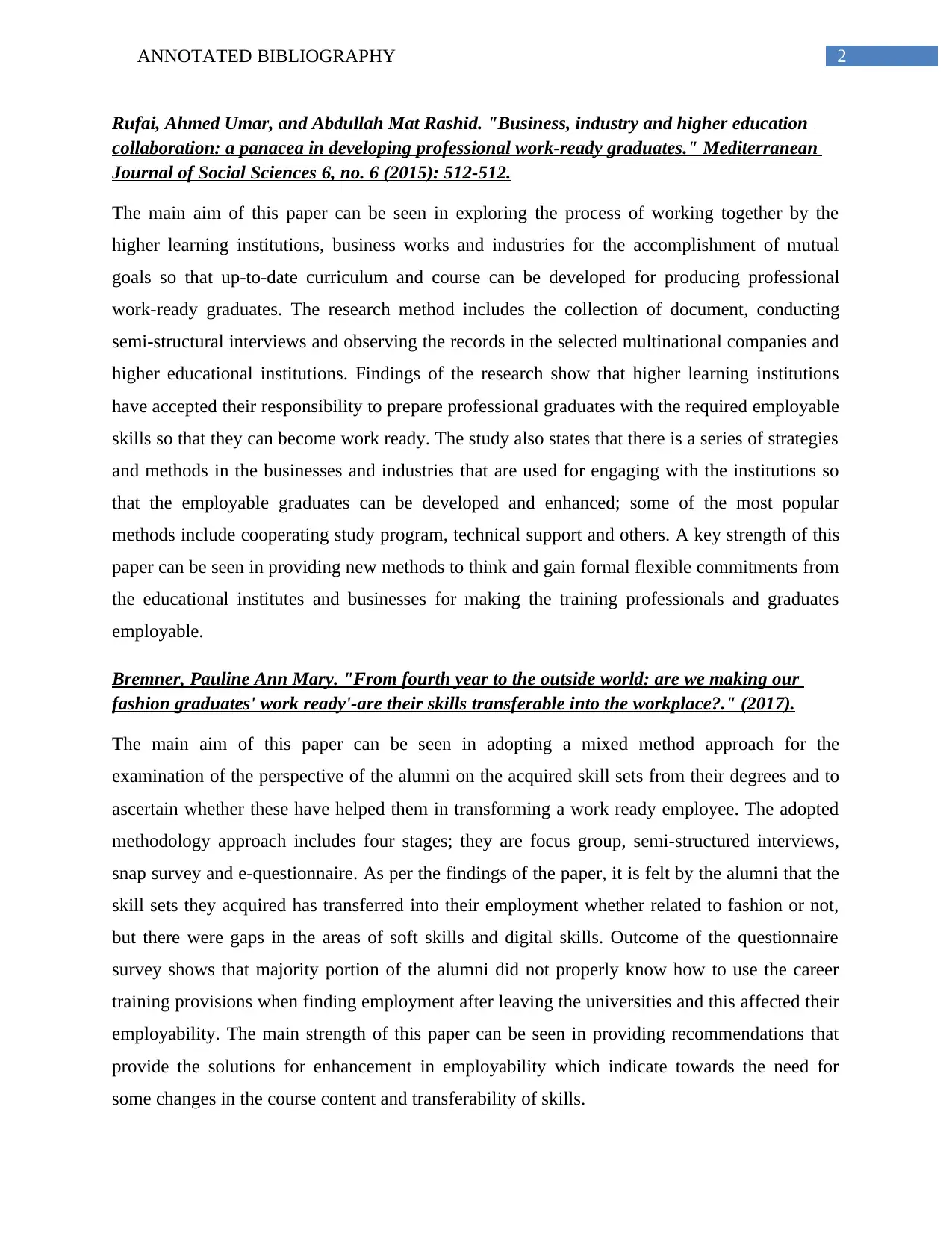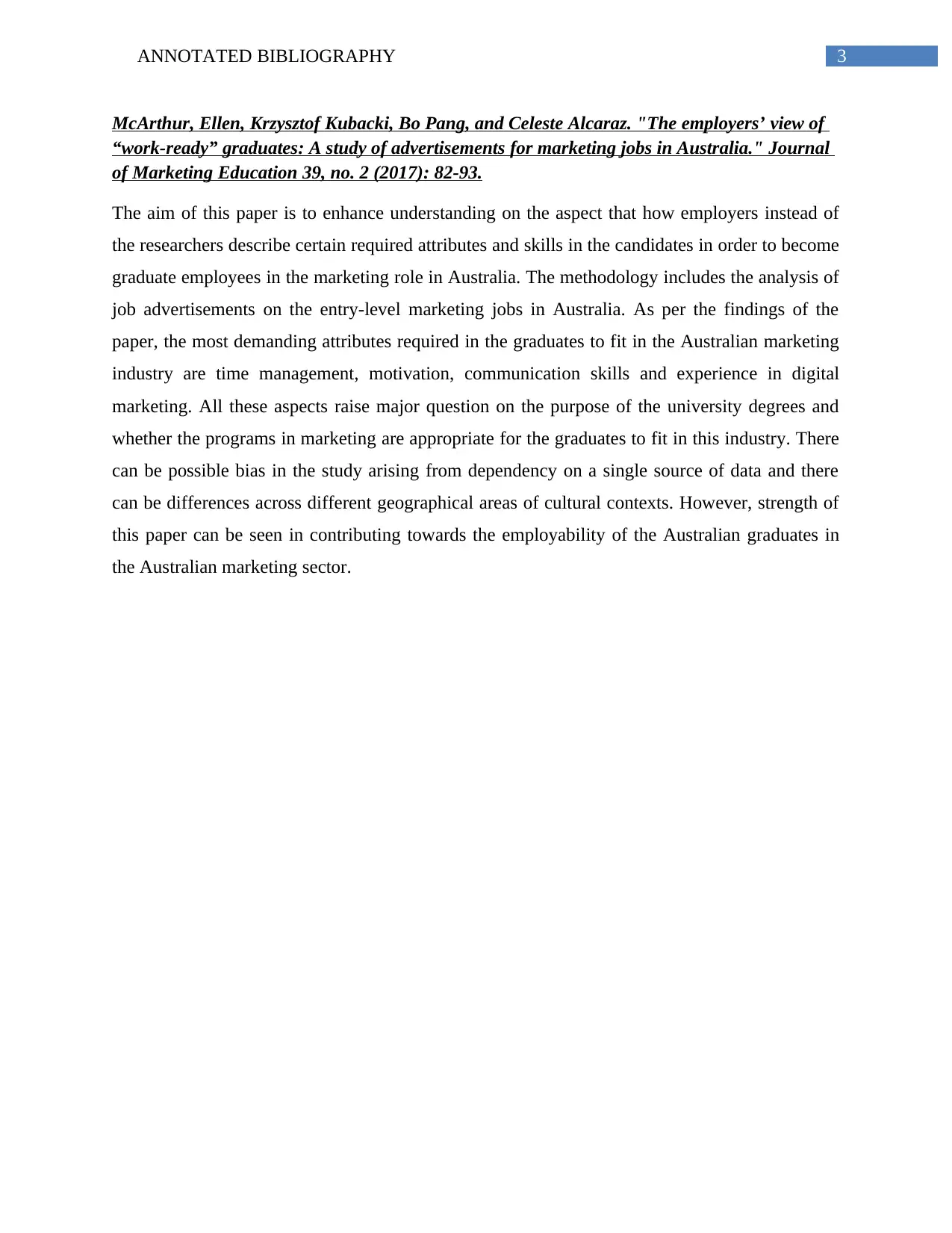Annotated Bibliography: Business Graduate Employability Research
VerifiedAdded on 2022/08/24
|5
|1343
|85
Annotated Bibliography
AI Summary
This annotated bibliography provides a detailed overview of research focused on business graduate employability. It examines key aspects such as the skills required for work-ready graduates, the role of higher education institutions, and the perspectives of employers and students. The bibliography includes analyses of several research papers, including Jackson's work on graduate transferability, Tymon's study on student perspectives, Rufai and Rashid's research on collaboration between higher education and industry, Bremner's examination of fashion graduate employability, and McArthur et al.'s study on employer views in the Australian marketing sector. Each entry summarizes the paper's aim, methodology, key findings, and strengths, offering a comprehensive understanding of the challenges and opportunities in preparing business graduates for the workforce.

Running head: ANNOTATED BIBLIOGRAPHY
Annotated Bibliography
Name of the Student
Name of the University
Author’s Note
Annotated Bibliography
Name of the Student
Name of the University
Author’s Note
Paraphrase This Document
Need a fresh take? Get an instant paraphrase of this document with our AI Paraphraser

1ANNOTATED BIBLIOGRAPHY
Jackson, Denise. "Business graduate employability–where are we going wrong?." Higher
Education Research & Development 32, no. 5 (2013): 776-790.
This paper mainly discusses about the concept of transfer in the graduates while proposing a
model of employability of graduates incorporating the process. The key objective behind using
the model is to ascertain the extent to which the graduates transfer to the workplace for making
them the ‘work ready’ graduates. There are two stages in the model for assessing the contribution
of the development of non-technical skills in the graduate employees. Even if the relevant
stakeholders assume that the transfer of graduates takes place naturally, this transfer is a highly
complex process that includes the characteristics of the workplaces. It is highlighted by the
proposed model that there is a necessity of change in role and attitude of the graduates for the
improvement of non-technical skills in the workplaces. The strength of this paper can be seen in
considering the perception of all stakeholders involved such as the graduates, employers and
educators in the transfer process. In addition, the consideration of the two stages which are
influence on non-technical skill development and graduate employability and transfer from
classroom to workplace has made the used model more effective to get to the results.
Tymon, Alex. "The student perspective on employability." Studies in higher education 38, no.
6 (2013): 841-856.
The main aim of this research paper is the assessment of the perspective of the students in the
areas of business studies, marketing and human resource management on employability. This
article assesses the case of more than 400 undergraduate students for this purpose. The study was
conducted by collecting data from undergraduate students from one post-92 UK University. It
can be seen from the outcome of this paper that there is not much alignment between the views
of students and other group of stakeholders on employability. General findings of the paper show
that the confidence and positive views of the students towards employability increases from first
year to final year. Moreover, the undergraduate students are needed to develop certain skills that
are largely helpful in employability such as communication, team working, information
technology, organizing and planning; and the personal attributes include adaptability, flexibility,
commitment, dedication and hardworking. However, the paper indicates towards the uncertainty
that whether these skills can be developed from practice.
Jackson, Denise. "Business graduate employability–where are we going wrong?." Higher
Education Research & Development 32, no. 5 (2013): 776-790.
This paper mainly discusses about the concept of transfer in the graduates while proposing a
model of employability of graduates incorporating the process. The key objective behind using
the model is to ascertain the extent to which the graduates transfer to the workplace for making
them the ‘work ready’ graduates. There are two stages in the model for assessing the contribution
of the development of non-technical skills in the graduate employees. Even if the relevant
stakeholders assume that the transfer of graduates takes place naturally, this transfer is a highly
complex process that includes the characteristics of the workplaces. It is highlighted by the
proposed model that there is a necessity of change in role and attitude of the graduates for the
improvement of non-technical skills in the workplaces. The strength of this paper can be seen in
considering the perception of all stakeholders involved such as the graduates, employers and
educators in the transfer process. In addition, the consideration of the two stages which are
influence on non-technical skill development and graduate employability and transfer from
classroom to workplace has made the used model more effective to get to the results.
Tymon, Alex. "The student perspective on employability." Studies in higher education 38, no.
6 (2013): 841-856.
The main aim of this research paper is the assessment of the perspective of the students in the
areas of business studies, marketing and human resource management on employability. This
article assesses the case of more than 400 undergraduate students for this purpose. The study was
conducted by collecting data from undergraduate students from one post-92 UK University. It
can be seen from the outcome of this paper that there is not much alignment between the views
of students and other group of stakeholders on employability. General findings of the paper show
that the confidence and positive views of the students towards employability increases from first
year to final year. Moreover, the undergraduate students are needed to develop certain skills that
are largely helpful in employability such as communication, team working, information
technology, organizing and planning; and the personal attributes include adaptability, flexibility,
commitment, dedication and hardworking. However, the paper indicates towards the uncertainty
that whether these skills can be developed from practice.

2ANNOTATED BIBLIOGRAPHY
Rufai, Ahmed Umar, and Abdullah Mat Rashid. "Business, industry and higher education
collaboration: a panacea in developing professional work-ready graduates." Mediterranean
Journal of Social Sciences 6, no. 6 (2015): 512-512.
The main aim of this paper can be seen in exploring the process of working together by the
higher learning institutions, business works and industries for the accomplishment of mutual
goals so that up-to-date curriculum and course can be developed for producing professional
work-ready graduates. The research method includes the collection of document, conducting
semi-structural interviews and observing the records in the selected multinational companies and
higher educational institutions. Findings of the research show that higher learning institutions
have accepted their responsibility to prepare professional graduates with the required employable
skills so that they can become work ready. The study also states that there is a series of strategies
and methods in the businesses and industries that are used for engaging with the institutions so
that the employable graduates can be developed and enhanced; some of the most popular
methods include cooperating study program, technical support and others. A key strength of this
paper can be seen in providing new methods to think and gain formal flexible commitments from
the educational institutes and businesses for making the training professionals and graduates
employable.
Bremner, Pauline Ann Mary. "From fourth year to the outside world: are we making our
fashion graduates' work ready'-are their skills transferable into the workplace?." (2017).
The main aim of this paper can be seen in adopting a mixed method approach for the
examination of the perspective of the alumni on the acquired skill sets from their degrees and to
ascertain whether these have helped them in transforming a work ready employee. The adopted
methodology approach includes four stages; they are focus group, semi-structured interviews,
snap survey and e-questionnaire. As per the findings of the paper, it is felt by the alumni that the
skill sets they acquired has transferred into their employment whether related to fashion or not,
but there were gaps in the areas of soft skills and digital skills. Outcome of the questionnaire
survey shows that majority portion of the alumni did not properly know how to use the career
training provisions when finding employment after leaving the universities and this affected their
employability. The main strength of this paper can be seen in providing recommendations that
provide the solutions for enhancement in employability which indicate towards the need for
some changes in the course content and transferability of skills.
Rufai, Ahmed Umar, and Abdullah Mat Rashid. "Business, industry and higher education
collaboration: a panacea in developing professional work-ready graduates." Mediterranean
Journal of Social Sciences 6, no. 6 (2015): 512-512.
The main aim of this paper can be seen in exploring the process of working together by the
higher learning institutions, business works and industries for the accomplishment of mutual
goals so that up-to-date curriculum and course can be developed for producing professional
work-ready graduates. The research method includes the collection of document, conducting
semi-structural interviews and observing the records in the selected multinational companies and
higher educational institutions. Findings of the research show that higher learning institutions
have accepted their responsibility to prepare professional graduates with the required employable
skills so that they can become work ready. The study also states that there is a series of strategies
and methods in the businesses and industries that are used for engaging with the institutions so
that the employable graduates can be developed and enhanced; some of the most popular
methods include cooperating study program, technical support and others. A key strength of this
paper can be seen in providing new methods to think and gain formal flexible commitments from
the educational institutes and businesses for making the training professionals and graduates
employable.
Bremner, Pauline Ann Mary. "From fourth year to the outside world: are we making our
fashion graduates' work ready'-are their skills transferable into the workplace?." (2017).
The main aim of this paper can be seen in adopting a mixed method approach for the
examination of the perspective of the alumni on the acquired skill sets from their degrees and to
ascertain whether these have helped them in transforming a work ready employee. The adopted
methodology approach includes four stages; they are focus group, semi-structured interviews,
snap survey and e-questionnaire. As per the findings of the paper, it is felt by the alumni that the
skill sets they acquired has transferred into their employment whether related to fashion or not,
but there were gaps in the areas of soft skills and digital skills. Outcome of the questionnaire
survey shows that majority portion of the alumni did not properly know how to use the career
training provisions when finding employment after leaving the universities and this affected their
employability. The main strength of this paper can be seen in providing recommendations that
provide the solutions for enhancement in employability which indicate towards the need for
some changes in the course content and transferability of skills.
⊘ This is a preview!⊘
Do you want full access?
Subscribe today to unlock all pages.

Trusted by 1+ million students worldwide

3ANNOTATED BIBLIOGRAPHY
McArthur, Ellen, Krzysztof Kubacki, Bo Pang, and Celeste Alcaraz. "The employers’ view of
“work-ready” graduates: A study of advertisements for marketing jobs in Australia." Journal
of Marketing Education 39, no. 2 (2017): 82-93.
The aim of this paper is to enhance understanding on the aspect that how employers instead of
the researchers describe certain required attributes and skills in the candidates in order to become
graduate employees in the marketing role in Australia. The methodology includes the analysis of
job advertisements on the entry-level marketing jobs in Australia. As per the findings of the
paper, the most demanding attributes required in the graduates to fit in the Australian marketing
industry are time management, motivation, communication skills and experience in digital
marketing. All these aspects raise major question on the purpose of the university degrees and
whether the programs in marketing are appropriate for the graduates to fit in this industry. There
can be possible bias in the study arising from dependency on a single source of data and there
can be differences across different geographical areas of cultural contexts. However, strength of
this paper can be seen in contributing towards the employability of the Australian graduates in
the Australian marketing sector.
McArthur, Ellen, Krzysztof Kubacki, Bo Pang, and Celeste Alcaraz. "The employers’ view of
“work-ready” graduates: A study of advertisements for marketing jobs in Australia." Journal
of Marketing Education 39, no. 2 (2017): 82-93.
The aim of this paper is to enhance understanding on the aspect that how employers instead of
the researchers describe certain required attributes and skills in the candidates in order to become
graduate employees in the marketing role in Australia. The methodology includes the analysis of
job advertisements on the entry-level marketing jobs in Australia. As per the findings of the
paper, the most demanding attributes required in the graduates to fit in the Australian marketing
industry are time management, motivation, communication skills and experience in digital
marketing. All these aspects raise major question on the purpose of the university degrees and
whether the programs in marketing are appropriate for the graduates to fit in this industry. There
can be possible bias in the study arising from dependency on a single source of data and there
can be differences across different geographical areas of cultural contexts. However, strength of
this paper can be seen in contributing towards the employability of the Australian graduates in
the Australian marketing sector.
Paraphrase This Document
Need a fresh take? Get an instant paraphrase of this document with our AI Paraphraser

4ANNOTATED BIBLIOGRAPHY
References
Bremner, Pauline Ann Mary. "From fourth year to the outside world: are we making our fashion
graduates' work ready'-are their skills transferable into the workplace?." (2017).
Jackson, Denise. "Business graduate employability–where are we going wrong?." Higher
Education Research & Development 32, no. 5 (2013): 776-790.
McArthur, Ellen, Krzysztof Kubacki, Bo Pang, and Celeste Alcaraz. "The employers’ view of
“work-ready” graduates: A study of advertisements for marketing jobs in Australia." Journal of
Marketing Education 39, no. 2 (2017): 82-93.
Rufai, Ahmed Umar, and Abdullah Mat Rashid. "Business, industry and higher education
collaboration: a panacea in developing professional work-ready graduates." Mediterranean
Journal of Social Sciences 6, no. 6 (2015): 512-512.
Tymon, Alex. "The student perspective on employability." Studies in higher education 38, no. 6
(2013): 841-856.
References
Bremner, Pauline Ann Mary. "From fourth year to the outside world: are we making our fashion
graduates' work ready'-are their skills transferable into the workplace?." (2017).
Jackson, Denise. "Business graduate employability–where are we going wrong?." Higher
Education Research & Development 32, no. 5 (2013): 776-790.
McArthur, Ellen, Krzysztof Kubacki, Bo Pang, and Celeste Alcaraz. "The employers’ view of
“work-ready” graduates: A study of advertisements for marketing jobs in Australia." Journal of
Marketing Education 39, no. 2 (2017): 82-93.
Rufai, Ahmed Umar, and Abdullah Mat Rashid. "Business, industry and higher education
collaboration: a panacea in developing professional work-ready graduates." Mediterranean
Journal of Social Sciences 6, no. 6 (2015): 512-512.
Tymon, Alex. "The student perspective on employability." Studies in higher education 38, no. 6
(2013): 841-856.
1 out of 5
Related Documents
Your All-in-One AI-Powered Toolkit for Academic Success.
+13062052269
info@desklib.com
Available 24*7 on WhatsApp / Email
![[object Object]](/_next/static/media/star-bottom.7253800d.svg)
Unlock your academic potential
Copyright © 2020–2025 A2Z Services. All Rights Reserved. Developed and managed by ZUCOL.





